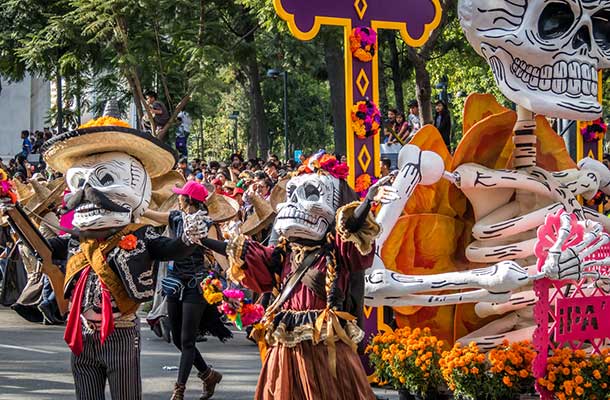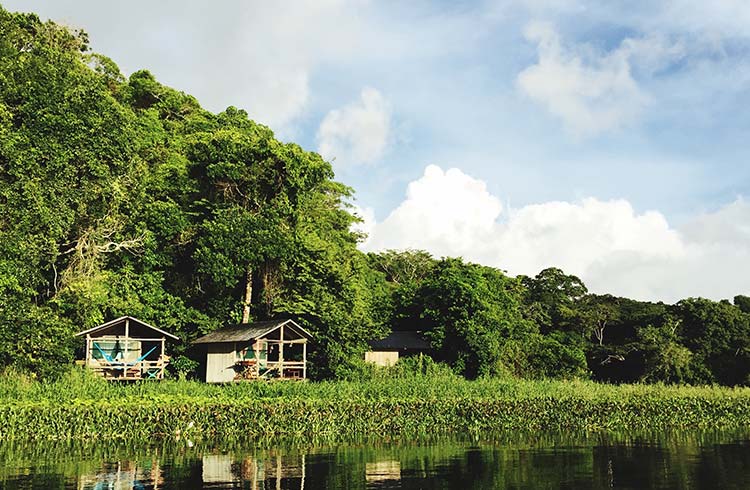Day of the Dead in Mexico: Dia de los Muertos
Mexico’s carnivalesque remembrance of departed souls is one of the world’s most universally familiar festivals.
 Photo © iStock/diegograndi
Photo © iStock/diegograndi
- Location
- Dates
- Description
- Level of Participation
- Essentials
- Other Local Attractions
- Travel Safety Tips
Location
Oaxaca, Mexico
Dates
1st and 2nd of November
Description
Its papier-mâché skeletons and candy skulls are as recognisable as the jack-o’-lanterns at Halloween. Westerners find the Latino rave from beyond the grave, with its upbeat treatment of immortality, both fascinating and confronting.
In anticipation of the gloriously grisly event, stores and markets fill with miniature coffins, skulls and skeletons made of chocolate, marzipan, paper, cardboard or clay. Many of them are engaged in highly un-skeletonlike activities such as riding bicycles, playing music or getting married.
In a belief system inherited from the Aztecs, Mexicans believe their dead are lurking in Mictlan, a kind of spiritual waiting room, and they can return to their homes at this time of year. Families thus begin preparations to help the spirits find their way home and to make them welcome, starting with an arch made of bright yellow marigolds – a symbolic doorway from the underworld. An altar is erected and piled high with offerings to the invisible visitors: flowers, ribbons, coloured candles, tamales (steam-cooked corn-meal dough), fruit and corn. Two important additions are a container of water, because the spirits arrive thirsty after their journey, and pan de muertos (bread of the dead). The loaf is made with egg yolks, fruits and tequila or mezcal, and is adorned with, or shaped as, a symbol of death.
The first day, Día de Angelitos (Day of the Little Angels), is dedicated to dead children, and the toys they once loved are placed on the altar.
The rituals are particularly important if the household has suffered a bereavement in the previous year. Women will spend all day cooking the favourite food of the dead relative for the customary feast, in which friends and family gather to toast the ghostly visitors.
The event climaxes with a visit to the cemetery. There might be a funfair en route, with neon-lit rides and stands selling crucifix waffles and cooked cactus snacks. Families will devote a day to cleaning the graves, decorating them with candles and flores del muerto (flowers of the dead), having picnics and dancing to mariachi bands. By now, the streets are full of papier-mâché skeletons, which are life-size but could never pass for the real thing in their dresses, jewellery, flowery boas and hats. A cigarette dangles jauntily from a white hand, a hoop earring hangs against a bare jawbone.
Again, such apparitions can be traced back to Aztec lore. The death god, Mictlantecutli, is often depicted with a skull-like face in pre-Hispanic artefacts. The skeletal street urchins became a major fixture in the late 19th century, when the great engraver José Guadalupe Posada used the occasion to satirise society and explore the theme of death as the ultimate leveller. In his famous calaveras, skeletal figures cheerfully engage in everyday life, working, dancing, courting, drinking and riding horses into battle. One of his most enduring characters is La Calavera Catrina, a female skeleton in an elaborate low-cut dress and flamboyant flower-covered hat, suggestively revealing a bony leg and an ample bust that is all ribs and no cleavage.
The event is, like many aspects of post-colonial Mexico, a melange of influences. Its origins stretch back to the Aztec month of Miccailhuitontli, which was dedicated to deathly Mictlantecutli’s equally scary wife, Mictecacihuat. It originally fell around August, but the Christian conquistadors, hoping to assimilate the heathen holiday through their favoured tactic of cultural mestizaje (mixing), moved it to the day after All Saint’s Day.
Level of Participation
3 – everyone’s invited to the party, even the dead.
Essentials
Celebrations take place all over the country, but their heartland is southern Mexico, where indigenous culture is strongest. Mixquic, southeast of Mexico City, is known as ‘City of the Dead’ for its procession that calls at shrines to the deceased. A popular location is Oaxaca, where there are graveyard tours and a ‘best altar’ competition.
If you do find yourself in the north, head to Guanajuato, where salesmen dole out mummy candies outside the gruesome Museo de las Momias (Museum of Mummies). On Janitzio Island, Lake Pátzcuaro, the arrival of flower-covered, candle-lit canoes begins a nightlong vigil-come-party.
Although you have to work hard to reach small villages and organise accommodation there, it’s worth getting out of the main towns and cities to catch more traditional festivities.
Other Local Attractions
Situated in rugged countryside, Oaxaca is a Spanish-built city of narrow streets.
Travel Safety Tips
In most cases, the celebrations for Dia De Los Muertos are large, jubilant and a lot of fun – but you should take precautions, especially when it comes to pick pockets and scamsters. There are a lot of attractions – dancing skeletons, puppeteers, musicians, market stalls and food vendors, and with such an array of goings-on, there will be the inevitable bunch who look to capitalize on those looking the other way. So keep your money secure, preferably in a body-belt, and keep a cautious eye out for scamsters.
It is also typical for food offerings to be placed in shrines revering the souls of lost loved ones and friends, and in many cases when the reverence is complete, the food is consumed. While it may be tempting to grab a free bite, some of the food sits there for days, so its best to stick with food you have purchased and have some level of quality control over. It’s also simple politeness.
More Info: Visit Mexico
Related articles
Simple and flexible travel insurance
You can buy at home or while traveling, and claim online from anywhere in the world. With 150+ adventure activities covered and 24/7 emergency assistance.
Get a quote
No Comments